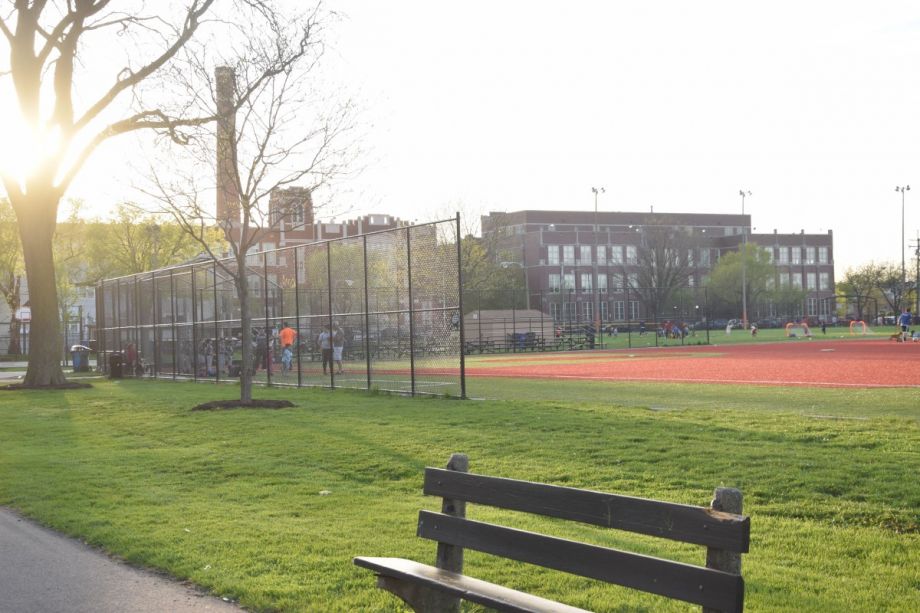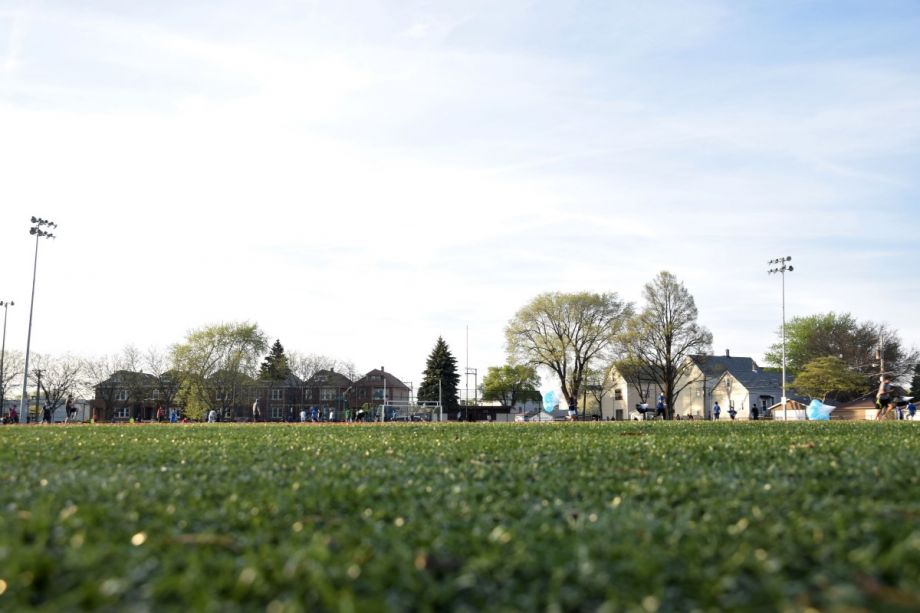Idalia Flores shakes her head when she reflects on what the conditions used to be like at Chicago’s Kelly Park, where she played as a child.
Big holes dotted an uneven landscape littered with shards of broken glass and patches of dirt. Rain would pool on the baseball diamonds and across sidewalks, blocking access to sections of the park.
When Flores attended Thomas Kelly High School across the street, the park was often in such bad shape that her soccer teammates instead trained on a hardwood gym floor, and ran drills up the stairs of the school.
“I would look at parks in nicer areas around the city and wonder why we couldn’t have the same standards,” says Flores, who’s now 26.
The small 7-acre Kelly Park is located in Brighton Park, a mostly Latino, working-class community of about 49,000 on Chicago’s Southwest Side. Flores is part of a volunteer parks advocacy group that secured major renovations at Kelly Park after more than five years of organizing.
Work began in 2011, and now there’s a brand-new all-weather soccer field (by popular demand of neighborhood youth) and playground, and the baseball diamonds have been fixed.
In Chicago, income and race can determine access to jobs, bank loans, quality schools and parks, and more than 1 in 5 Brighton Park residents live at or below the poverty level. Conditions in parks in many low-income neighborhoods across Chicago don’t match those in more affluent areas. Historic disparities in funding for facilities managed by the Chicago Park District, the department that manages city parks, has often resulted in disrepair and neglect. An analysis by Chicago Reporter of parks budget data found that more than half of the $500 million spent on improvements between 2011 and 2014 went to just 10 of the city’s 77 neighborhoods — with 7 of the 10 located in mostly white, affluent communities.
In order to improve their local parks, residents have turned to mobilizing to push elected officials and city agencies, and seek private funding.
After graduating high school, Flores, who was born in Zacatecas, Mexico, got involved in the work of improving the park. She’d heard that residents had been organizing for 10 years, winning small renovations and introducing programming for youth. She wanted to do more.
Where other residents saw problems with Kelly Park, Flores saw opportunities for community organizing. When she heard some people say it was unsafe for families, she brought families into the planning process. When neighbors talked about “delinquents” hanging in the park, she invited them to help her push for youth programs. “People should be able to change their parks and have a say in [park] development,” Flores says. “Residents are the ones who know the needs in the community.”
In 2010, Flores and other residents partnered with local community organization Brighton Park Neighborhood Council and parks advocacy organization Friends of the Parks to form a park advisory council. In Chicago, these volunteer groups meet once a month to talk about ways to promote park use and identify what improvements are needed. Advisory councils register with the Chicago Park District in order to establish a partnership and access training, but they don’t receive any public funding.
In 2015, Flores was elected president of Kelly Park Advisory Council. The group has held rummage sales, 5k run fundraisers and other events to build support and raise money for the park renovation.
“[Volunteers] are people from around the neighborhood who care about their park,” Flores says. “The council empowers them to suggest improvements. They want a healthy space for the community.”
These efforts, Flores says, helped to show the parks department that Kelly Park users were “committed” to the process. The Chicago Park District considers demand for renovations when evaluating the viability of park projects. But, despite their success so far, Flores wishes residents didn’t have to knock on so many doors to ask for money to improve their park when they are already paying taxes. “I don’t think it should be that way,” she says, “but that is the system we have in place.”
According to Chicago parks advocate Kenneth Newman, many park advisory councils formed in response to the city’s neglect of communities living in poverty in terms of equitably dispersing tax dollars for parks. (In a first decree of its kind, the federal government investigated Chicago parks in the early 1980s and ordered the Park District to upgrade facilities in black and Latino neighborhoods.)
Jessica Faulkner, spokesperson for Chicago Park District, says that the department helps advisory councils “locate alternate funding sources to enhance park facilities.” Flores says she and other KPAC members have benefited from attending advisory council trainings and conferences organized by the Park District.
In April, after the resolution of a budget battle with the state, Chicago officials announced a $26 million project to renovate 20 aging facilities in the city. The program will be paid for by Illinois Department of Natural Resources grant funding and Park District capital funds. “Some of our field houses are more than 100 years old,” said Mayor Rahm Emanuel in a press release about the money. “This is why ‘Save Chicago’s Treasures’ is so critical. Maintaining the city’s historic neighborhood gems are the essential investments that improve the quality of life for residents, build strong neighborhoods and create a better Chicago.”

Kim DuBuclet, director of community affairs at CPD, says it’s not only common for councils to have to find a variety of funding sources, it’s the standard. Throughout the city, funding outside city coffers often covers the majority of costs in a park’s capital improvement project, with money coming from a mix of philanthropy, foundations grants and federal funds.
In the case of Kelly Park, Chicago Public Schools and Chicago Park District each kicked in $500,000, while U.S Soccer Foundation put in another $100,000. (The soccer field’s price tag was over $1.9 million.) Almost $500,000 came from state capital funds and city coffers. The rest was covered by grants from ESPN, the National Football League, the Pritzker Foundation, and the Chicago Cubs.
Flores intends to keep working with fellow community members on Kelly Park improvements. She sees the benefits to the Brighton Park neighborhood so clearly — from providing a safe space for children to play, to a space for families to exercise and find respite.
“Afterschool programs, parks, job programs for youth and violence prevention programs should all be properly funded,” she says. “It’s all connected.”
Last summer, Brighton Park native Christian Ayala, 19, became a father for the first time. He has played at the park for years and says he is looking forward to hanging out there with his family. “It feels better coming here,” Ayala says. “It feels more like a park that is for everyone.” But he wants to see the sidewalk renovated soon. Currently, the path doesn’t completely wrap around the park and people are forced to walk across grass and dirt plots to reach certain sections of the park.
Correction: This article has been edited to correct the size of Kelly Park, and start dates of the renovation and Flores’ KPAC presidency.

Martín Xavi Macías is a multimedia journalist and digital media educator. He was born and raised in Chicago. His reporting has appeared in Yes Magazine, Chicago Magazine, Truthout, National Public Radio and other outlets. He has a master's in journalism from Columbia College.
Follow Martín Xavi .(JavaScript must be enabled to view this email address)















